从Request库理解HTTP消息
Posted yc紫日
tags:
篇首语:本文由小常识网(cha138.com)小编为大家整理,主要介绍了从Request库理解HTTP消息相关的知识,希望对你有一定的参考价值。
背景
requests库官方文档地址
http://docs.python-requests.org/en/master/
作者博客
github地址
https://github.com/requests/requests
环境搭建
基本环境
python、pip
注:pip freeze -- 查看当前已经安装的pip包
安装其他必须软件
virtualenv
作用
初始化一个空环境(也可以不初始化)
使用 pip / easy_install 是为了能够良好的管理起来你的包,这类似deb之流。
之所以需要用 VirtualEnv,关键的目的是把你当前开发/生产的 Python 环境和其他的 Python 环境隔离开来。例如你的 Proj1 需要用到 LibA 的版本1.0,而你的 Proj2 需要用到LibA的2.0,如果不加以区分,那么就会可能造成冲突。
在 VirtualEnv 中,每一个 VirtualEnv 的环境,都是隔离的,需要的包等都是单独的,你可以认为这是一个沙盒(SandBox),这时候 pip / easy_install 等运行时候依赖的 Python 也是隔离的,既 $VENV_HOME/bin/python 而非 /usr/bin/python。
一般的,yum / apt 安装的会安装在系统的路径中,针对 Python, 则是 Global 的 PYTHONPATH。很难做到隔离。
而从源代码安装的,一般的会根据你的运行时 Python 命令进行隔离。也就是如果你启用了 VirtualEnv (source $VENV_HOME/bin/activate)后,从源码安装的也会在这个 venv 下。
安装virtualenv
pip install virtualenv
使用virtualenv初始化当前文件夹
virtualenv .env
激活当前文件夹的virtualenv
windows:.env/Script/activate
linux:source .env/bin/activate
注:deactivate可以退出虚拟环境
requests库
pip install requests
httpbin.org
测试用,由于http://httpbin.org/服务器在美国,所以可以在本地搭建个类似环境测试
pip install gunicorn httpbin
gunicorn httpbin:app
注:windows上无法安装gunicorn
HTTP协议
概念
HyperText Transfer Protocol超文本传输协议
The Hypertext Transfer Protocol is a stateless(无状态的), application-level protocol(应用层协议) for distributed(分布式), collaborative(协作式), hepertext information system(超文本信息系统)
显示一次http通信的整个过程
curl -v https://www.imooc.com/ >/data01/yc_files/http_contact_demo.log
显示分析

urllib
概念
python原生网络库
urllib、urllib2、urllib3的关系
urllib和urllib2是独立的模块,并没有直接的关系,两者相互结合实现复杂的功能
urllib和urllib2在python2中才可以使用
requests库中使用了urllib3(多次请求重复使用一个socket)
urllib和request区别
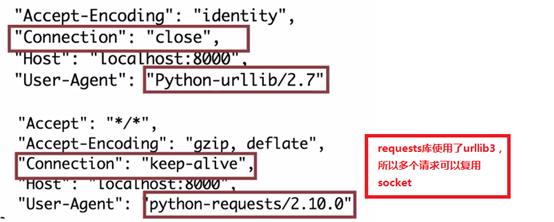
urlib_demo

# -*- coding:utf-8 -*- import urllib2 import urllib URL_simple="http://httpbin.org/ip" URL_get="http://httpbin.org/get" def urllib_simple_use(): response = urllib2.urlopen(URL_simple) print( \'>>>>Response Headers:\') print( response.info()) print( \'>>>>Response Status Code:\') print( response.getcode()) print( \'>>>>Response :\') print( \'\'.join([line for line in response])) def urllib_params_use(): params = urllib.urlencode({\'param1\':\'hello\',\'param2\':\'world\'}) response = urllib2.urlopen(\'?\'.join([URL_get,params])) print( \'>>>>Response Headers:\') print( response.info()) print( \'>>>>Response Status Code:\') print( response.getcode()) print( \'>>>>Response :\') print( \'\'.join([line for line in response])) if __name__ == \'__main__\': print( \'>>>>Urllib Simple Use:\') urllib_simple_use() print( \'>>>>Urllib Params Use:\') urllib_params_use()
requests_demo
quick start: http://docs.python-requests.org/en/latest/user/quickstart/

# -*- coding:utf-8 -*- import requests URL_simple="http://httpbin.org/ip" URL_get="http://httpbin.org/get" def requests_simple_use(): response = requests.get(URL_simple) print( \'>>>>Request Headers:\') print( response.request.headers) print( \'>>>>Request body:\') print( response.request.body) print( \'>>>>Response url:\') print( response.url) print( \'>>>>Response Headers:\') print( response.headers) print( \'>>>>Response Status Code:\') print( response.status_code) print( \'>>>>Response Status Code Reason:\') print( response.reason) print( \'>>>>Response :\') print( response.text) print( response.json()) def requests_params_use(): params = {\'param1\':\'hello\',\'param2\':\'world\'} response = requests.get(URL_get,params=params) print( \'>>>>Request Headers:\') print( response.request.headers) print( \'>>>>Request body:\') print( response.request.body) print( \'>>>>Response url:\') print( response.url) print( \'>>>>Response Headers:\') print( response.headers) print( \'>>>>Response Status Code:\') print( response.status_code) print( \'>>>>Response Status Code Reason:\') print( response.reason) print( \'>>>>Response :\') print( response.text) print( response.json()) if __name__ == \'__main__\': print( \'>>>>Requests Simple Use:\') requests_simple_use() print( \'>>>>Requests Params Use:\') requests_params_use()
扩展
RFC7230 -> RFC7235阅读
发送请求

import requests import json from requests.exceptions import RequestException ROOT_URL=\'https://api.github.com\' def better_print(src_json): \'\'\' 格式化打印json \'\'\' return json.dumps(src_json,indent=4) def get_simple_use(): \'\'\' API获得指定用户的用户信息 \'\'\' response = requests.get(\'/\'.join([ROOT_URL,\'users/wahaha\'])) print(\'>>>>Response text:\') print(better_print(response.json())) def get_auth_use(): \'\'\' API获得指定用户的email信息--明文,不建议方法。 当然,123456是错误的密码。 建议通过简易oauth认证。 \'\'\' # response = requests.get(\'/\'.join([ROOT_URL,\'user/emails\'])) response = requests.get(\'/\'.join([ROOT_URL,\'user/emails\']),auth=(\'wahaha\',\'123456\')) print(\'>>>>Response text:\') print(better_print(response.json())) def get_params_use(): \'\'\' get + 带参URL 获得11号之后的user信息 \'\'\' response = requests.get(\'/\'.join([ROOT_URL,\'users\']),params={\'since\':11}) print( \'>>>>Request Headers:\') print( response.request.headers) print( \'>>>>Request body:\') print( response.request.body) print( \'>>>>Response url:\') print( response.url) print(\'>>>>Response text:\') print(better_print(response.json())) def patch_json_use(): \'\'\' json参数 + patch 修改用户邮箱 \'\'\' response = requests.patch(\'/\'.join([ROOT_URL,\'user\']),auth=(\'wahaha\',\'123456\'),json={\'name\':\'test_name\',\'email\':\'hello-world@163.com\'}) print( \'>>>>Request Headers:\') print( response.request.headers) print( \'>>>>Request body:\') print( response.request.body) print( \'>>>>Response url:\') print( response.url) print(\'>>>>Response text:\') print(better_print(response.json())) def request_exception_use(): \'\'\' 设定超时时间 + 异常处理 timeout = x 握手+发送response超时时间-x timeout = ( x, y) 握手超时时间-x, 发送response超时时间-y \'\'\' try: response = requests.get(\'/\'.join([ROOT_URL,\'users\']),timeout=(0.1,0.2),params={\'since\':11}) except RequestException as e: print(e) else: print( \'>>>>Request Headers:\') print( response.request.headers) print( \'>>>>Request body:\') print( response.request.body) print( \'>>>>Response url:\') print( response.url) print(\'>>>>Response text:\') print(better_print(response.json())) def my_request_use(): \'\'\' 简单模拟requests库底层实现发送requset方法 \'\'\' # 导库 from requests import Request,Session # 初始化session my_session = Session() # 初始化headers my_headers = {\'User-Agent\':\'fake1.1.1\'} # 初始化request my_request = Request(\'GET\',\'/\'.join([ROOT_URL,\'users\']),headers=my_headers, params={\'since\':\'11\'}) # 准备request my_prepared_request = my_request.prepare() # 发送request,并用response接受 my_response = my_session.send(my_prepared_request,timeout=(3,3)) print( \'>>>>Request Headers:\') print( json.dumps(dict(my_response.request.headers),indent=4)) print( \'>>>>Request body:\') print( my_response.request.body) print( \'>>>>Response url:\') print( my_response.url) print( \'>>>>Response Headers:\') print( json.dumps(dict(my_response.headers),indent=4)) print( \'>>>>Response Status Code:\') print( my_response.status_code) print( \'>>>>Response Status Code Reason:\') print( my_response.reason) # print( \'>>>>Response :\') # print(better_print(my_response.json())) def hook_function(response, *args, **kw): print (\'回调函数>>>\',response.headers[\'Content-Type\']) def event_hook_use(): \'\'\' 事件钩子,即回调函数,指定获得response时候调用的函数 \'\'\' response = requests.get(\'http://www.baidu.com\',hooks={\'response\':hook_function}) if __name__=="__main__": # get_simple_use() # get_auth_use() # get_params_use() # patch_json_use() # request_exception_use() # my_request_use() event_hook_use()
参数类型
不同网站接口所对应的发送请求所需的参数类型不同
https://developer.github.com/v3/#parameters
1.URL参数
https://xxx/xx?a=1&b=2&c=3
request库中使用requests.get(url, params={\'a\':\'1\',\'b\':\'2\',\'c\':\'3\'})
优势:跳转方便,速度快
劣势:明文,长度有限制
2.表单参数提交
Content-Type: application/x-www-form-urlencoded
request库中使用requests.post(url, data={\'a\':\'1\',\'b\':\'2\',\'c\':\'3\'})
3.json参数提交
Content-Type: application/json
request库中使用request.post(url, json={\'a\':\'1\',\'b\':\'2\',\'c\':\'3\'})
举例网站
使用参考:https://developer.github.com/v3/guides/getting-started/
请求方法
GET -- 查看资源
POST -- 增加资源
PATCH -- 修改资源
PUT -- 修改资源(比PATCH修改的力度大)
DELETE -- 删除资源
HEAD -- 查看响应头
OPTIONS -- 查看可用请求方法
异常处理
requests库中显示引发的所有异常都继承自requests.exceptions.RequestException,所以直接捕获该异常即可。
自定义request
git@github.com:requests/requests.git
通过阅读request源码,了解Session(proxy,timeout,verify)、PreparedRequest(body,headers,auth)、Response(text,json...)
处理响应
响应基本API
响应的附加信息
status_code 响应码 E:\\yc_study\\python\\request\\request\\HTTP状态码.html
reason 响应码解释
headers 响应头
url 该响应是从哪个url发来的
history 重定向的历史信息
elapsed 接口调用时长
request 该响应对应的request
响应的主体内容
encoding 主体内容的编码格式
content 主体内容,str类型
text 主体内容,unicode类型
json 主体内容,json类型
raw 流模式下,返回一个urllib3.response.HTTPResponse类型的对象,可以分块取出数据
>>> r = requests.get(\'https://api.github.com/events\', stream=True) >>> r.raw <requests.packages.urllib3.response.HTTPResponse object at 0x101194810> >>> r.raw.read(10) \'\\x1f\\x8b\\x08\\x00\\x00\\x00\\x00\\x00\\x00\\x03\'
iter_content 流模式下,返回字节码,但会自动解码,可以分块取出数据
with open(filename, \'wb\') as fd: for chunk in r.iter_content(chunk_size=128): fd.write(chunk)
注1:iter_content和raw的区别
使用Response.iter_content会处理很多你直接使用Response.raw时必须处理的内容。在流式传输下载时,以上是检索内容的首选和推荐方式。请注意,chunk_size可以随意调整为更适合您的用例的数字。
Response.iter_content会自动解码gzip和deflate传输编码。Response.raw是一个原始的字节流,它不转换响应内容。如果您确实需要访问返回的字节,请使用Response.raw。
注2:使用流模式读取文件时,最终需要关闭流
http://www.cnblogs.com/Security-Darren/p/4196634.html

# -*- coding:utf-8 -*- def get_image(img_url): import requests # response = requests.get(img_url,stream=True) # 引入上下文管理器的closing来实现关闭流 from contextlib import closing # with closing(requests.get(img_url,stream=True,headers={\'User-Agent\':\'Mozilla/5.0 (Windows NT 6.1; WOW64) AppleWebKit/537.36 (KHTML, like Gecko) Chrome/55.0.2883.87 Safari/537.36\'})) as response: with closing(requests.get(img_url,stream=True)) as response: print(\'Request Headers>>:\\n\',response.request.headers) with open(\'demo1.jpg\',\'wb\') as img_file: for chunk in response.iter_content(128): img_file.write(chunk) def main(): img_url=\'https://timgsa.baidu.com/timg?image&quality=80&size=b9999_10000&sec=1512314249355&di=6371398ddfba39ce23fc02b74b2d59cf&imgtype=0&src=http%3A%2F%2Fpic.58pic.com%2F58pic%2F16%2F42%2F96%2F56e58PICAu9_1024.jpg\' # img_url=\'http://img5.imgtn.bdimg.com/it/u=2502798296,3184925683&fm=26&gp=0.jpg\' get_image(img_url) if __name__ == \'__main__\': main()
事件钩子--回调函数
见 “发送请求” 下的代码
HTTP认证
基本认证
原理
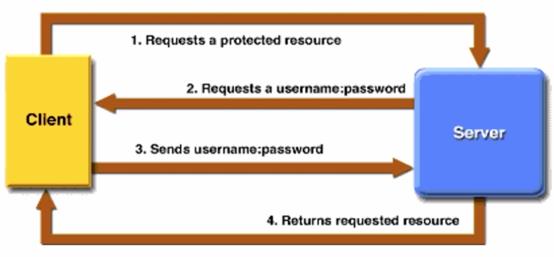
使用
即上面说过的明文auth
requests.get(\'https://api.github.com/user\',auth=(\'wahaha\', \'123456\'))
结果
此种方式在request库中是使用的base64编码的,直接解码可以得到用户名和密码
headers如下:

oauth认证
原理
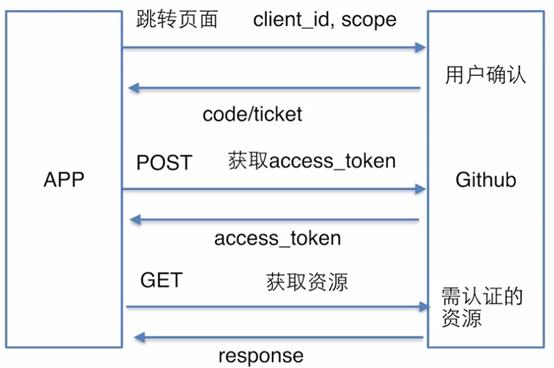
oauth的流程
http://www.barretlee.com/blog/2016/01/10/oauth2-introduce/
官方自定义oauth示例
http://www.python-requests.org/en/master/user/advanced/#custom-authentication
使用
简单使用:在settings->developer settings -> personal access tokens处生成一个测试token,并选择scope,将该token值放到request的headers中即可
结果
headers如下:

proxy代理
原理

背景
本机不可以访问外网
代理服务器可以访问外网
配置代理服务器后,所有访问外网的请求会被发送到代理服务器,然后代理服务器发送该请求到外网服务器,然后·外网服务器返回响应到代理服务器,代理服务器再返回到本机
更多
搜索 heroku + socks
cookie
原理
由于HTTP本身是无状态的,即每个HTTP请求应该是独立的,但是由于现实需要后面的请求需要依赖前面的请求所获得的结果,所以产生了cookie。
1.浏览器第一次发送HTTP请求(无cookie)
2.服务器返回带cookie的HTTP响应
3.浏览器解析相应中的cookie,并保存在本地
4.浏览器第二次发送请求(带cookie)
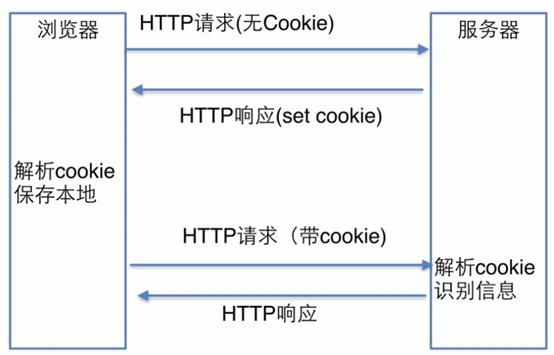
官方使用
http://docs.python-requests.org/en/master/user/quickstart/#cookies
session
原理
由于cookie需要将用户的数据在每次请求中都附带,而数据在网络上传输是不安全的,所以产生了session,session会将主要数据保存在服务器端,而只给浏览器端返回一个带session-id的cookie,一定保障了数据的安全性与传输效率
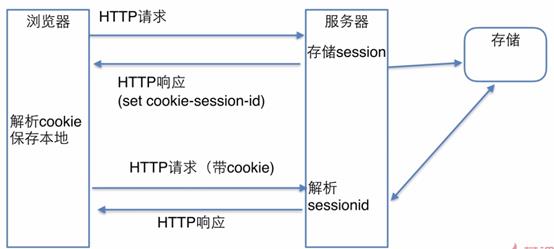
以上是关于从Request库理解HTTP消息的主要内容,如果未能解决你的问题,请参考以下文章
